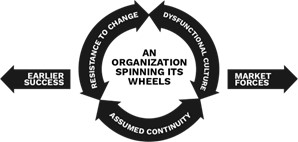Agency Leadership Lessons From ‘Toy Story’ Creator

By: Diane T. Keil-Hipp
We all know the movie “Toy Story” and its lovable characters Woody, Buzz, Jessie, and the rest of the gang that come to life when humans aren’t looking. But what could this animated movie possibly have to do with leadership? Well, the lessons for business leaders come from “Toy Story” creator Pixar and its cofounder, Ed Catmull.
In a recent Wall Street Journal article, Catmull shared his wisdom about change, long-standing success, and the elusive “sweet spot.” Interestingly, Catmull’s comments align with the research on the internal factors necessary for organizations of all sizes to survive over time.
First, let’s take a quick overview of the Pixar journey. Catmull was recruited by George Lucas in 1979 to create a digital film unit. In 1986, Steve Jobs purchased the unit from Lucas and founded Pixar along with Alvy Ray Smith and Catmull. Nine years after its founding, Pixar released “Toy Story,” and in 2006, Pixar was sold to Disney for $7.4 billion.
Now, before you discount this story because “all tech companies got rich in this era,” consider that in 1986, Sun Microsystems and Silicon Graphics were on top. Today, you’d be hard-pressed to find someone who recognizes those names. Although it is hard to believe that technology firms could ignore signs of their technology changing, that is what happened. Today, neither firm exists.
Catmull understood that, although technology was a critical ingredient to Pixar’s success, organizational culture, its view of change, and its corporate attitude are the pillars technology rests on. As a leader, he was determined to build a company with a sustainable creative culture that encouraged communication and removed hierarchies.
As it turns out, these three pillars are foundational for all types and sizes of businesses, including insurance agencies. Here’s how each pillar affects agency performance and longevity:
1) Organizational culture. This defines the environment in which co-workers engage. Together, co-workers learn how to think, feel and behave. The behaviors that are validated by the environment are taught to new members as the correct way to think, feel and behave. Soon, a culture is born, whether productive or dysfunctional.
At Pixar, Catmull wanted to build a culture that encouraged communication and removed hierarchies. Nearly 40 years later, fostering this type of culture still takes attention and focus. But it is a non-negotiable effort for the longevity of the business.
A productive agency culture encourages employees’ ideas, rewards stellar performance and abounds with supportive conversations. But when culture is dysfunctional, the tentacles spread far and wide. Maybe you know of agencies where ideas are shut down, only favored employees are rewarded, and gossip thrives. These are all examples of a dysfunctional culture. When these behaviors are commonplace, the agency’s sustainability is at risk.
2) View of change. The organization’s view of change affects its desire to look into the future of consumer wants and needs. A resistant organization will be satisfied with the status quo and less likely to change tried-and-true processes for new approaches.
However, Catmull says there is no point of rest, no place for coasting, no sweet spot. “Even when you get to a place where everything seems right, people come in with new ideas, new technology, new expectations … we need a mindset that allows us to adapt when nothing is stable,” Catmull told the Wall Street Journal earlier this year. Although it seems like an oxymoron, embracing change must be a foundation.
Because many agencies are long-standing firms, resistance to change often prevails. The agency’s history and legacy can become its own worst enemy, preventing the firm from embracing new technology and recognizing changing consumer demands. For instance, do you know an agency that still relies on paper policies?
3) Corporate attitude. Corporate attitude is defined by the firm’s view of its future existence. If the firm is humble, it will not take its success for granted. However, a firm with an overly confident attitude about its future can ignore the changing winds. This type of attitude often emerges after an organization achieves great success. Even the most attentive leaders can get caught up in the moment. Who can blame leaders for basking in the glow after years of hard work?
But basking in the glow can open an organization up to being blindsided. Catmull admitted that Pixar had its share of problems. Internal rifts, discrimination and sexual misconduct blindsided him.
At agencies, a corporate attitude of over-confidence can be years in the making. Long-standing, generational businesses are especially susceptible to wearing rose-colored glasses that show an idyllic future. But assuming the agency will continue to thrive simply because it has prospered to this point is dangerous.
Often, agencies who suffer from this attitude blame others for their lack of sales growth and fail to reinvest in the business or strategically plan.
Spinning Wheels
The research supports Catmull’s observations. My research on organization decline led to the creation of the Spinning Wheels model, which illustrates how these three factors—culture, change and attitude—spin into liabilities, creating a dysfunctional culture that resists change and assumes its future is guaranteed.

When these three factors of change, culture and continuity become liabilities, the organization becomes inwardly focused, spinning in its busyness of following processes that brought earlier success.
But while the organization focuses inward, the consumer market is moving, likely in a different direction. Consumers will move away from firms that no longer meet their needs. But an organization that’s spinning its wheels thinks that its existing processes will still garner success. And if you think insurance agencies are immune to changing consumer needs, you are proving my point.
Don’t let your organization become a spinning wheel. Take the “Toy Story” lessons and pay attention to your organization’s culture, view of change and corporate attitude. If any one of these starts to spin inward, grab that wheel, stop the spinning and lead your firm toward the future market.
Diane T. Keil-Hipp is chief operating officer of Knight Insurance Group, headquartered in Toledo, Ohio. She is also a doctoral candidate at Bowling Green State University. Her dissertation research focuses on organizational decline.
Keil-Hipp created an organization traction survey to help firms diagnose their degree of spinning wheels. If you’re curious about how well your agency stacks up with these pillars, take the 10-minute survey.










